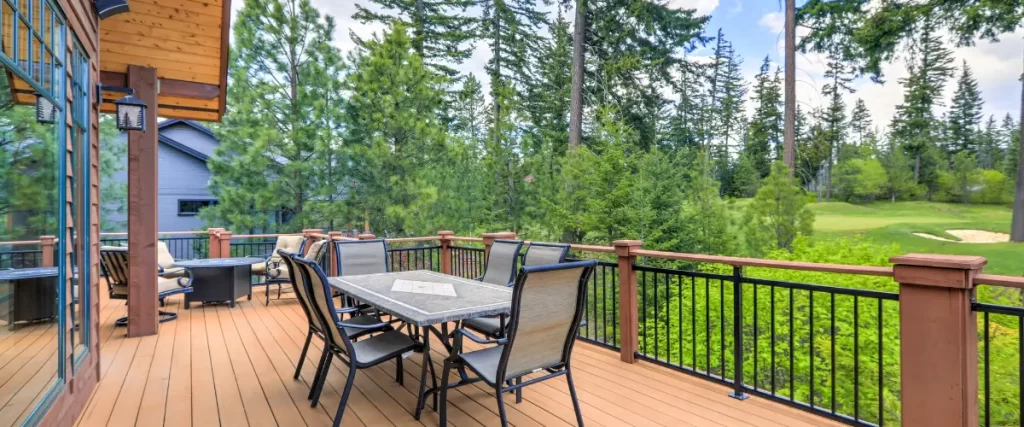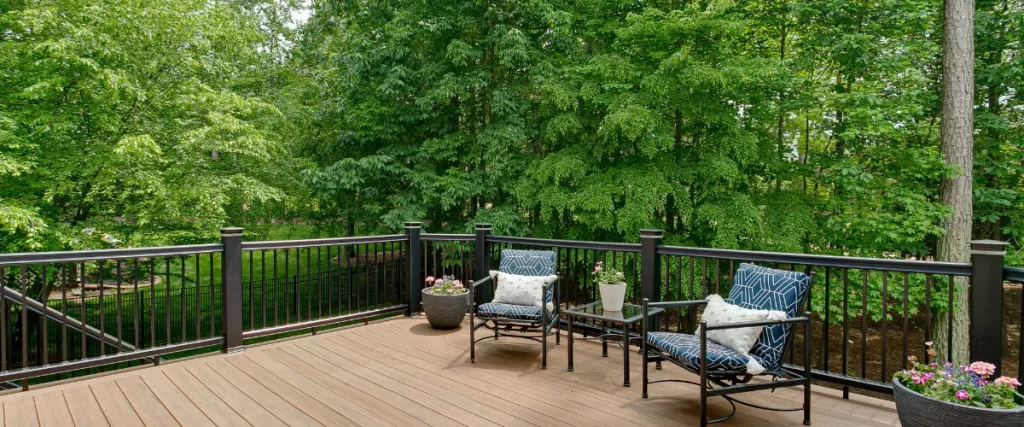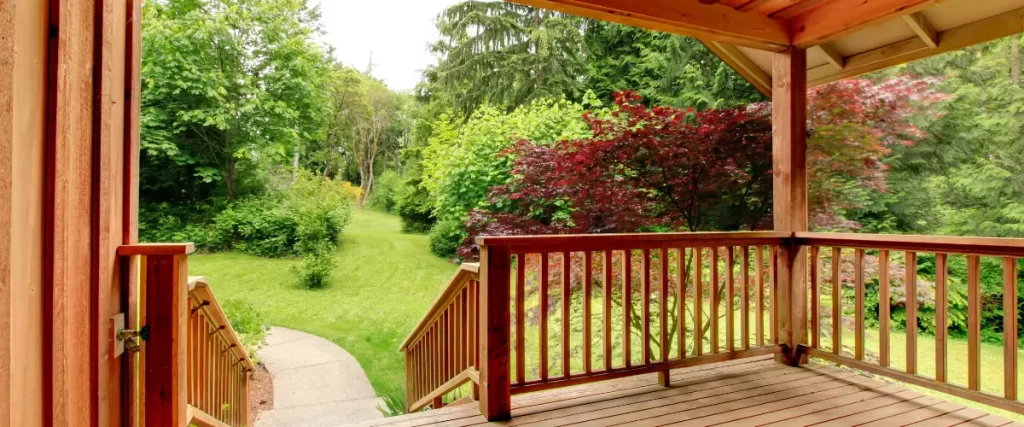As a homeowner in Omaha, you’re no stranger to the city’s hot, humid summers and unpredictable weather. While you might love having a beautiful wooden deck to enjoy during those warm months, the constant exposure to high humidity can lead to a frustrating and costly issue: wood rot.
If you’re not careful, your deck could start deteriorating sooner than you expect, which means costly repairs and even replacement. But don’t worry — you can take steps to protect your deck and extend its life, even in Omaha’s humid climate.
In this post, we’re going to dive deep into how Omaha’s high humidity affects wooden decks and explore the best ways to prevent rot, so you can enjoy your outdoor space for years to come. Whether you’re looking to maintain an existing deck or planning to build a new one, this guide will give you the practical tips you need to safeguard your investment.

How Omaha’s Humidity Affects Your Wooden Deck
Omaha’s climate is a mix of hot summers and cold winters, with high humidity levels, especially during the summer months. The combination of high temperatures and high humidity creates the perfect environment for wood to absorb moisture.
Wood, being a natural material, is highly susceptible to these environmental conditions. When wood absorbs moisture, it expands, and over time, this can lead to structural damage and the growth of mold, mildew, and ultimately, rot.
Here’s how this high humidity impacts your deck:
1. Wood Expansion and Contraction
Wood is a hygroscopic material, which means it naturally absorbs and releases moisture based on the surrounding environment. During humid periods, your deck boards will soak up moisture, causing the wood to swell. When humidity decreases, the wood will shrink. This constant cycle of expansion and contraction can cause the wood to crack and warp over time, weakening the deck’s structure.
2. Growth of Mold and Mildew
High humidity provides the perfect breeding ground for mold and mildew. These fungi thrive in moist environments, and if your deck is regularly exposed to humidity without proper ventilation or maintenance, you may notice black or green spots forming on the surface. Not only is this unsightly, but it can also cause long-term damage to your deck, as mold and mildew eat away at the wood fibers.
3. Wood Rot
Wood rot is the most significant threat to wooden decks in humid climates. When moisture is trapped in the wood for extended periods, it leads to decay. Fungal spores invade the wood and break down its fibers, weakening the material. Over time, this can lead to structural failure, causing boards to become soft, spongy, or even crumble apart.
Signs of Rot and Damage in Wooden Decks
Before we dive into prevention, it’s important to know how to spot signs of damage or rot. Look out for these red flags:
- Soft, Spongy Wood: If your wood feels soft or spongy to the touch, it’s a clear sign of rot. The wood has absorbed too much moisture and is beginning to decay.
- Discoloration: Black or dark stains on your deck are often an indication of mold or mildew growth, while lighter, grayish spots can indicate that the wood is drying out or deteriorating.
- Cracked or Splintered Wood: As the wood expands and contracts due to high humidity, cracks and splinters can form, making your deck not only less attractive but also unsafe.
- Foul Odors: A musty smell emanating from your deck could indicate that mold or mildew is present. This odor usually indicates that moisture has penetrated deep into the wood.
- Loose or Sagging Boards: If boards become loose or sag, it could be a sign that the underlying structure is weakening due to rot.

Best Ways to Prevent Rot on Your Wooden Deck in Omaha’s Humid Climate
Now that we’ve covered the issues humidity can cause, let’s look at how to protect your deck from moisture and prevent rot.
1. Choose the Right Wood for Your Deck
The type of wood you use for your deck plays a big role in how well it stands up to humidity and moisture. Some woods are naturally more resistant to rot and decay than others. Here are some popular choices:
- Pressure-Treated Lumber: This is the most common type of wood used for decking. It is treated with chemicals to resist rot and insect damage. While it’s more resistant to moisture than untreated wood, it still requires maintenance and care.
- Cedar and Redwood: These woods are naturally resistant to rot and decay. They have a high level of tannins, which help prevent moisture from penetrating the wood. While they may be a bit more expensive than pressure-treated wood, they are an excellent choice for humid climates.
- Ipe and Other Exotic Hardwoods: Hardwoods like Ipe are extremely dense and naturally resistant to rot and decay. These woods are ideal for decks in areas with high humidity, but they come with a higher price tag.
2. Seal and Stain Your Deck Regularly
One of the most effective ways to protect your wooden deck from moisture is by sealing it with a high-quality deck stain or sealer. Sealing your deck creates a waterproof barrier that prevents moisture from penetrating the wood. This can significantly reduce the risk of rot, mold, and mildew. Look for sealers that are specifically designed for humid climates, as they offer enhanced protection.
- Oil-Based Sealers: These are great for providing a rich finish that penetrates deep into the wood, providing long-lasting protection against moisture.
- Water-Based Sealers: These dry faster and have less odor, but they still offer good protection against the elements. They may require more frequent reapplication than oil-based sealers.
Make sure to clean your deck thoroughly before applying the sealer. It’s best to seal your deck every one to two years, depending on the wear and tear from weather conditions.
3. Improve Deck Ventilation
Ventilation is crucial for wooden decks in humid climates. Proper airflow allows the wood to dry faster and prevents moisture from becoming trapped in the material. Make sure your deck has enough space underneath to allow air to circulate freely. You can achieve this by ensuring that the boards are spaced properly, and there is adequate clearance from the ground. If necessary, consider adding ventilation openings along the sides of your deck.
4. Keep Gutters and Downspouts Clear
Clogged gutters and downspouts can cause water to overflow and pool around your deck, increasing the likelihood of moisture damage. Regularly clean your gutters to prevent water from collecting near the base of your deck. You should also ensure that downspouts direct water away from the foundation of your deck to keep moisture from seeping in.
5. Regular Cleaning and Maintenance
One of the best ways to prevent rot is to maintain your deck regularly. Sweep away debris such as leaves, dirt, and branches, as they can trap moisture and promote mold growth. Also, periodically clean the surface of your deck with a mild cleaning solution to remove mold, mildew, and grime that can cause long-term damage.
6. Fix Leaks and Water Damage Promptly
If you notice any signs of water damage or leaking on your deck, fix them as soon as possible. The longer water sits on the wood, the greater the chance of rot. Replace any damaged boards and address leaks immediately to prevent further deterioration.
Best Deck Manufacturers for Moisture-Resistant Decks
When it comes to building a moisture-resistant deck in Omaha, it’s crucial to choose the right materials. Here are some of the best manufacturers for moisture-resistant decking:
1. Trex
Trex is a leader in composite decking, known for its durability and moisture resistance, making it perfect for humid climates.
2. TimberTech
TimberTech offers composite decking materials that are engineered to resist moisture and provide long-lasting protection against rot.
3. Fiberon
Fiberon provides high-performance composite decking designed to withstand the toughest weather conditions, including high humidity.
4. AZEK
AZEK offers durable PVC decking that is resistant to moisture, making it ideal for high-humidity areas like Omaha.
5. Wolf Home Products
Wolf’s composite decking options are designed to resist moisture, mildew, and rot, providing a reliable solution for homeowners.
Frequently Asked Questions
Q1: How often should I seal my wooden deck in Omaha?
It’s recommended to reseal your deck every one to two years, depending on exposure to the elements.
Q2: Can I prevent wood rot with regular cleaning?
Yes, regular cleaning helps remove debris and moisture buildup, which reduces the risk of mold, mildew, and rot.
Q3: What’s the best type of wood for a deck in humid areas?
Cedar, redwood, and pressure-treated lumber are the best choices for decks in humid climates like Omaha.
Q4: How can I improve airflow under my deck?
Ensure there is sufficient clearance from the ground and consider adding ventilation openings or vents to enhance airflow.

Keep Your Deck Safe from Omaha’s Humidity
Omaha’s high humidity doesn’t have to ruin your wooden deck. By choosing the right materials, sealing your deck regularly, and maintaining it properly, you can prevent rot and extend the life of your outdoor space. Don’t let moisture damage take away your beautiful deck — take action today to protect it!
If you need help with your deck building, contact us at (402) 369-5724. We’re here to help!
